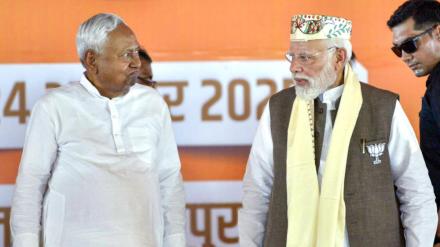The Bihar election trends are largely in line with what many exit polls had predicted. In fact, the numbers show that the National Democratic Alliance (NDA) is heading for a sweeping victory, with the bloc likely to win around 200 seats in the 243-member Bihar Assembly.
When we look closely at the seat tally between the BJP and the JDU — the two key partners in the NDA — the first question that comes to mind is: Which party will get the chief minister’s post this time?
Both the BJP and the JDU contested 101 seats each. As per the latest trends (on Election Commission of India website), the BJP is leading on 92 seats, while the JDU is ahead on around 82 seats. This gap, if trends convert into final results, will definitely shift the political mood within the NDA, giving the BJP a stronger position in the alliance.
If the BJP ends up as the single-largest party, it will naturally have more bargaining power. This is a worrying sign for JDU as Nitish Kumar has always been the face of the alliance in Bihar.
How 2025 is very different from 2020
In 2020, the NDA made a clear announcement. They said Nitish Kumar would be the chief minister, no matter how many seats the BJP won. Even though the BJP won more seats (74) than JDU (43), they still backed Nitish. At that time, the Rashtriya Janata Dal (RJD) under Tejashwi Yadav emerged as the single-largest party with 75 seats in Bihar.
But things have changed in 2025.
Throughout the campaign, the BJP said the elections were being fought under Nitish’s leadership. They praised his governance record. But whenever they were asked if Nitish would be the CM again, BJP leaders avoided giving a direct answer. They repeatedly said the party’s elected MLAs would decide the chief minister after the results.
They also insisted that there was no tension with the JDU and that seat-sharing had been fixed amicably. But political observers believe the messaging told a different story. The BJP seemed focused on making this a BJP-led election, not a Nitish-led one.
This gave a strong hint that the party wanted its own chief minister in Bihar for the first time.
Key signs that BJP wanted the CM post
Here are five clear indicators:
1. Equal seat share: BJP insisted on contesting the same number of seats as JDU — 101 each.
2. Strong performance: Early trends showed BJP leading on more seats than JDU, giving BJP more negotiating power.
3. No clear backing for Nitish as CM: Unlike 2020, not a single top BJP leader said that Nitish would be the chief minister after the polls.
4. Heavy campaigning by BJP top brass: Leaders like Amit Shah, PM Modi and JP Nadda held extensive rallies, showing that BJP was going all out.
5. Nitish’s absence from many of PM Modi’s rallies: This raised questions, although his health issues were visible during the campaign.
In politics, even small signals matter. And these signals suggest that the BJP had been preparing the ground for a major shift.
So who will be the next chief minister?
If the current trends hold, Bihar may see its first BJP chief minister since Independence. But predicting the exact name is difficult.
We have seen how unpredictable BJP’s choices can be.
In Madhya Pradesh, Chhattisgarh, Rajasthan and even Delhi, the BJP surprised everyone with unexpected CM picks. In Delhi, Rekha Gupta became chief minister, replacing Atishi of the AAP — a move few saw coming.
So, even in Bihar, the final decision may surprise everyone again.
What happens next?
If BJP remains the largest party, it is likely to push for a BJP chief minister. The party may try to convince JDU to accept this new arrangement.
But the name of the CM will only be known once NDA leaders meet after the full results.
For now, all signs point in one direction — this could be the moment when Bihar gets its first-ever BJP chief minister. The final picture will become clear only after the NDA reaches a consensus.
